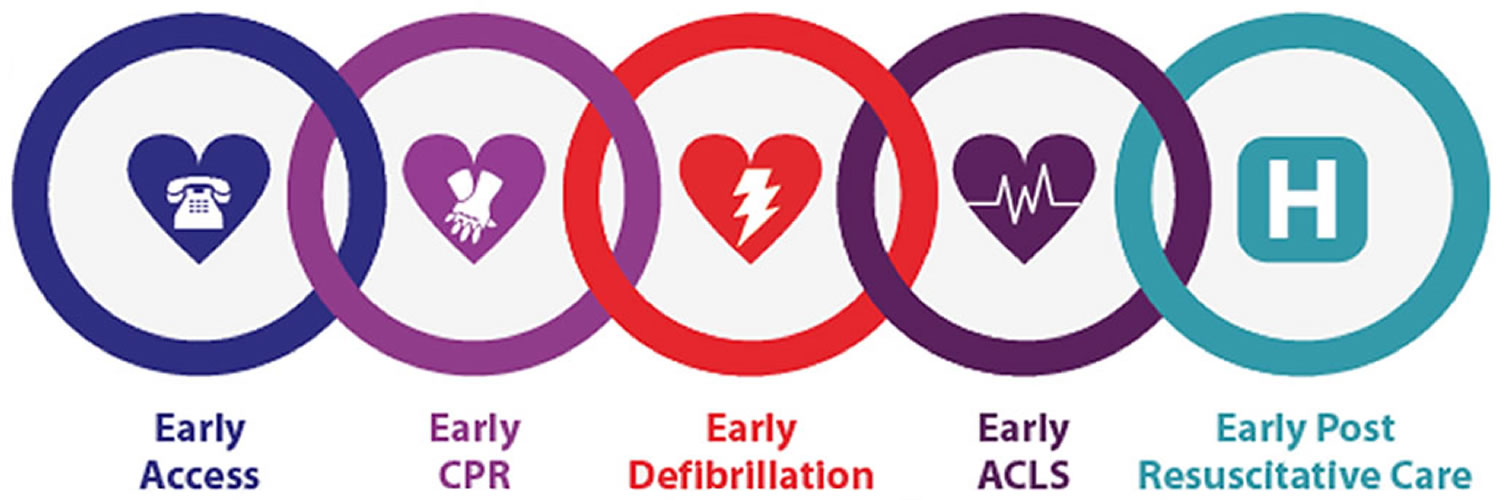Chain of Survival
In 1991, the American Heart Association introduced the “chain of survival” model 1, which has served as the dominant operational model for the resuscitation field since its publication and has been influential in affecting the delivery of efficient and effective care within discrete systems of some pioneering communities. The Chain of Survival, which originally evolved in the resuscitation field for use by emergency medical services systems, includes five key, time-sensitive, and interdependent links: early access, early CPR, early defibrillation, early ACLS, and early post-resuscitative care (see below).
Chain of Survival depicts the critical actions required to treat life-threatening emergencies, including heart attack, cardiac arrest, stroke, and foreign body airway obstruction. The links within this Chain of Survival include:
- Early Access: The first link, Early Access to the emergency response system includes early recognition of the cardiac emergency, activation of the emergency medical system (i.e., calling your local emergency services number as well as an internal alert system within specific facilities to trigger a response by designated trained and equipped personnel), discussion with a dispatcher, and the decision to send an emergency response vehicle 1. Early access to the emergency response system comprises all events that are initiated after the patient’s collapse until the arrival of emergency medical services personnel (paramedics).
- Early CPR: The second link, early cardiopulmonary resuscitation (CPR), is a set of actions that the rescuer performs in sequence to assess and support airway, breathing and circulation, after recognition of the cardiac emergency. It may overlap with efforts to activate the emergency medical system 1.
- Early Defibrillation: The third link, Early Defibrillation, is the delivery of electrical shock to the heart to convert the heart’s rhythm from ventricular fibrillation back to a normal heart rhythm 1. Several options for rapid defibrillation exist, including automated external, semi-automated external, or manual defibrillators 2.
- Early Advanced Cardiac Life Support: Beyond cardiopulmonary resuscitation (CPR) and defibrillation, highly trained and equipped pre-hospital emergency medical services personnel (paramedics) may need to deliver early advanced care life support (e.g., drug therapies, airway management, and other intravenous treatment and monitoring) to achieve spontaneous resuscitation, prior to the arrival of the patient at an advanced care facility 1.
- Early Post-Resuscitative Care: Early and effective post-arrest care following resuscitation has the potential to restore and preserve the cognitive and functional health status of cardiac arrest patients. It may include more advanced treatments, such as prognosis assessments, oxygenation and ventilation, targeted temperature management (e.g., hypothermia), cardiovascular management, cardiac catheterization, hemodynamic support, vasopressor therapies, extracorporeal membrane oxygenation, and metabolic management 3.
All of these links must rapidly and efficiently occur, sometimes sequentially or in parallel, to maximize the likelihood of survival and favorable neurologic and functional outcomes from cardiac arrest. The likelihood of successful resuscitation decreases if any link is delayed or improperly performed. Moreover, “separate specialized programs are necessary to develop strength in each link” 1. In recent decades, many organizations, departments, and individuals have developed myriad strategies and interventions to strengthen the cardiac chain of survival, specifically aimed at improving recognition of cardiac arrest and increasing the timeliness and quality of care. For example, some communities have implemented dispatcher-assisted CPR training to improve rates of bystander CPR performance. Other communities have implemented programs designed to promote high-quality CPR by emergency medical services personnel (paramedics) and have demonstrated significant improvement in patient outcomes.
Moreover, in order for the patient to have the best chance of surviving an out-of-hospital cardiac arrest, CPR and early defibrillation must be provided within the first 4 minutes of the cardiac arrest (the European Resuscitation Council/American Heart Association recommends 3 minutes), followed by Advanced Life Support within the first 8 minutes of the arrest.
References- Cummins RO, Ornato JP, Thies WH, Pepe PE. Improving survival from sudden cardiac arrest: The “chain of survival” concept. A statement for health professionals from the Advanced Cardiac Life Support Subcommittee and the Emergency Cardiac Care Committee, American Heart Association. Circulation. 1991;83(5):1832–1847.
- AHA (American Heart Association). Part 12: Science to survival: Strengthening the chain of survival in every community. Circulation. 2000;102(Suppl 1):I358–I370.
- Neumar RW, Otto CW, Link MS, Kronick SL, Shuster M, Callaway CW, Kudenchuk PJ, Ornato JP, McNally B, Silvers SM, Passman RS, White RD, Hess EP, Tang W, Davis D, Sinz E, Morrison LJ. Part 8: Adult advanced cardiovascular life support: 2010 American Heart Association guidelines for cardiopulmonary resuscitation and emergency cardiovascular care. Circulation. 2010;122(18 Suppl 3):S729–S767.





